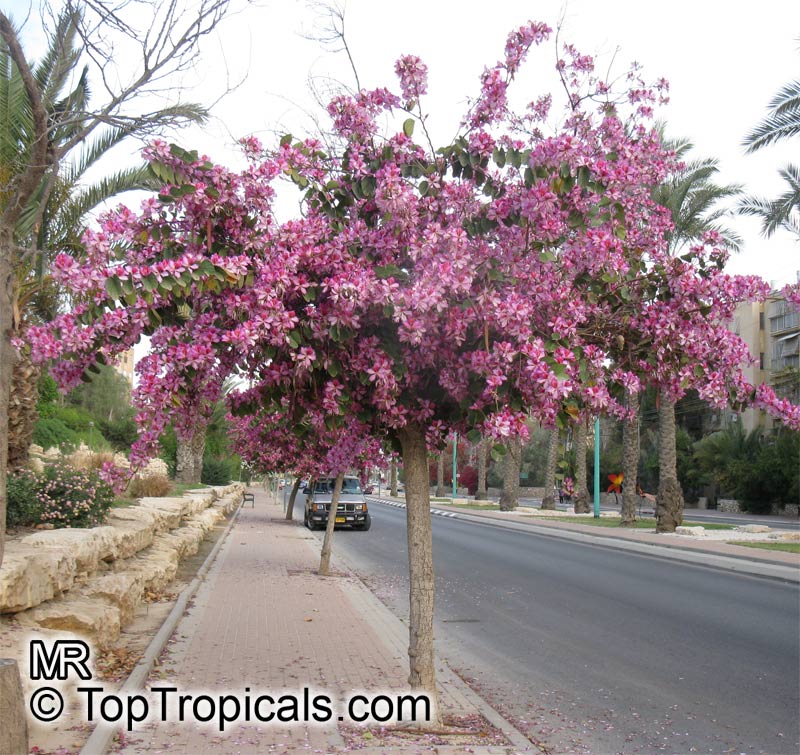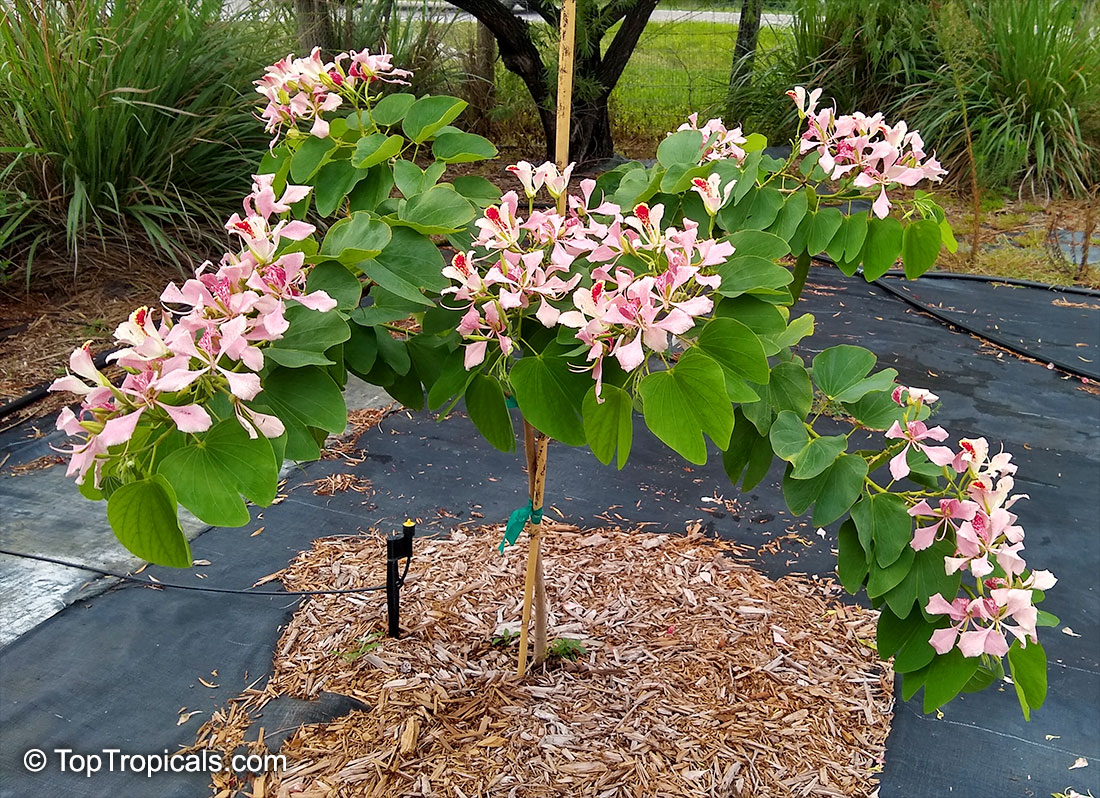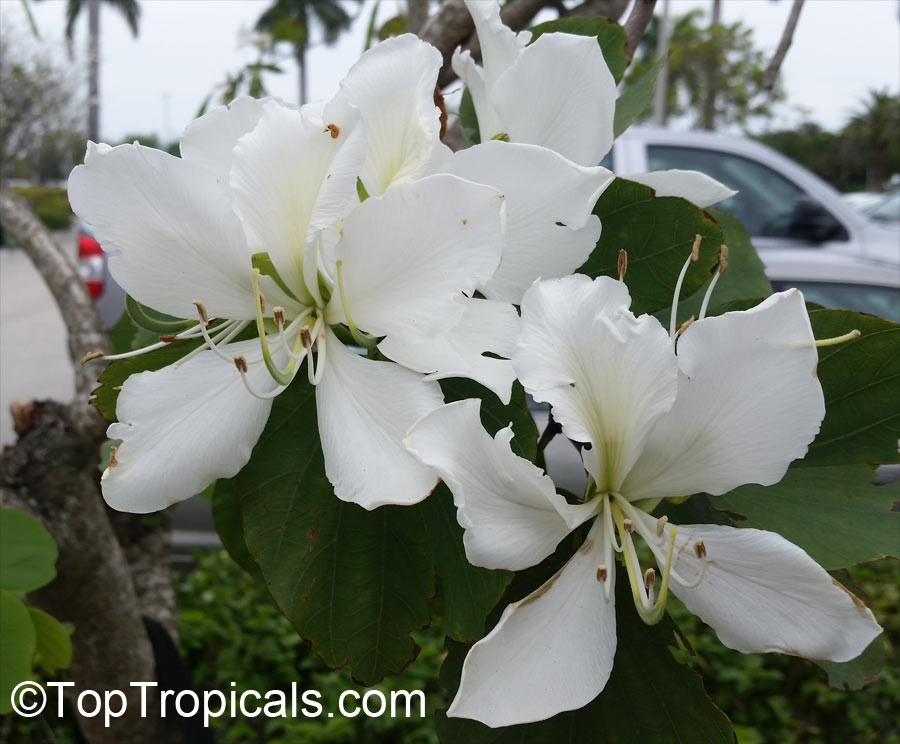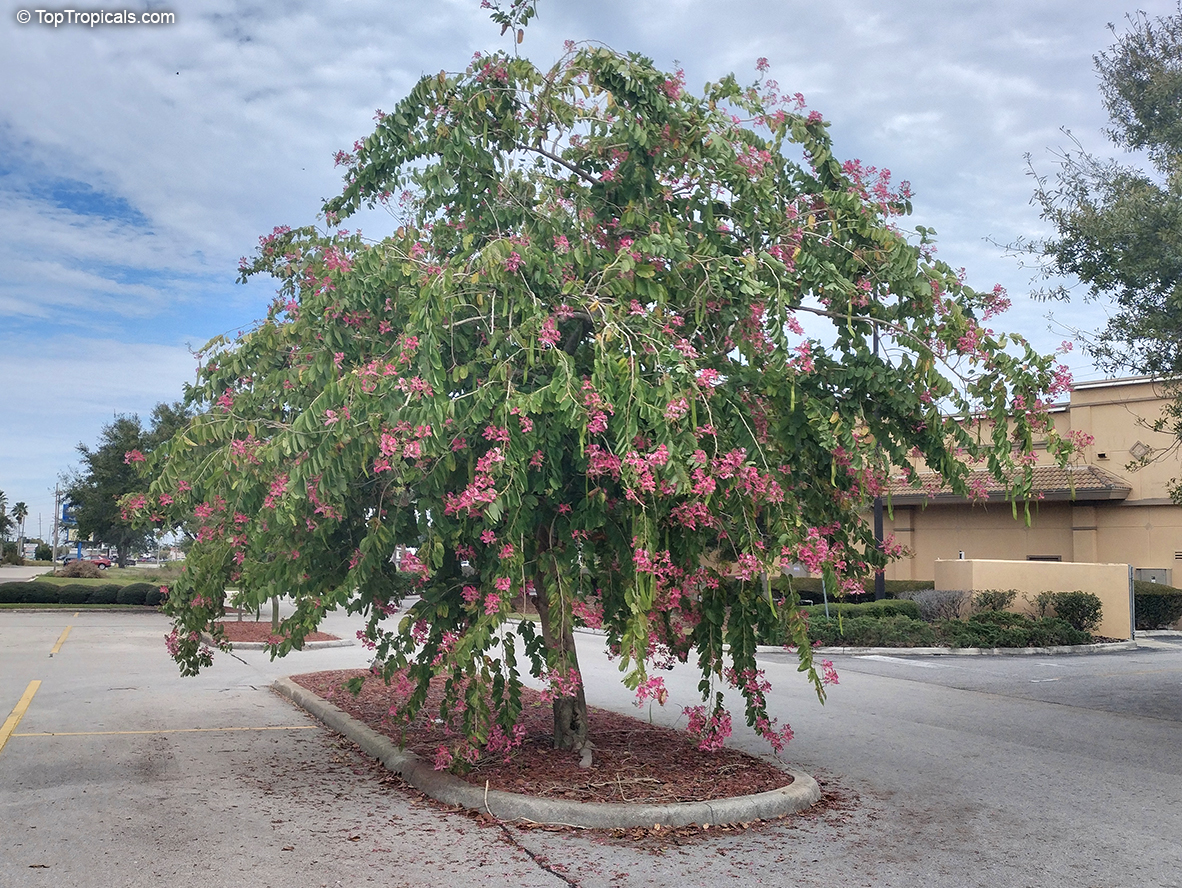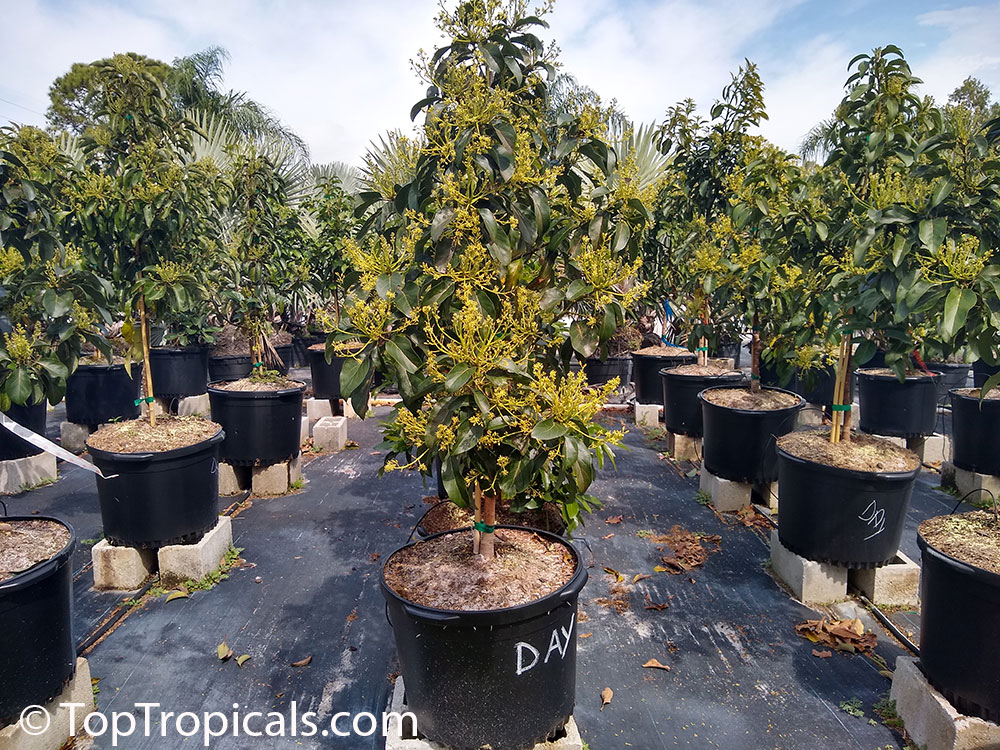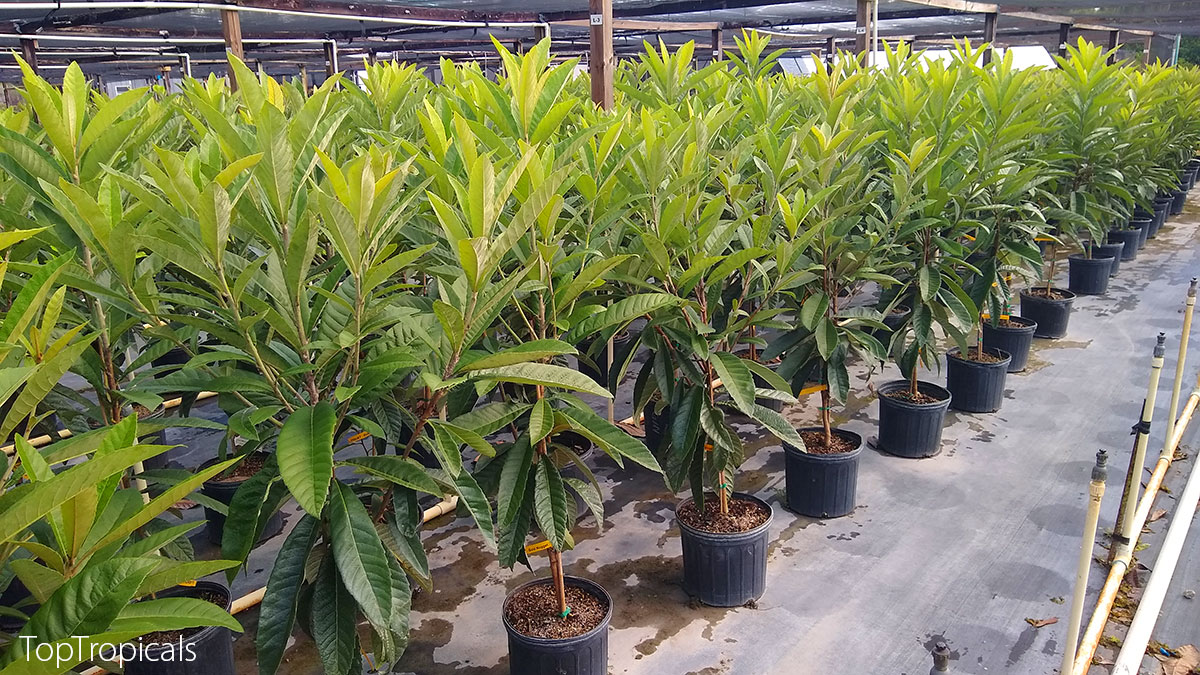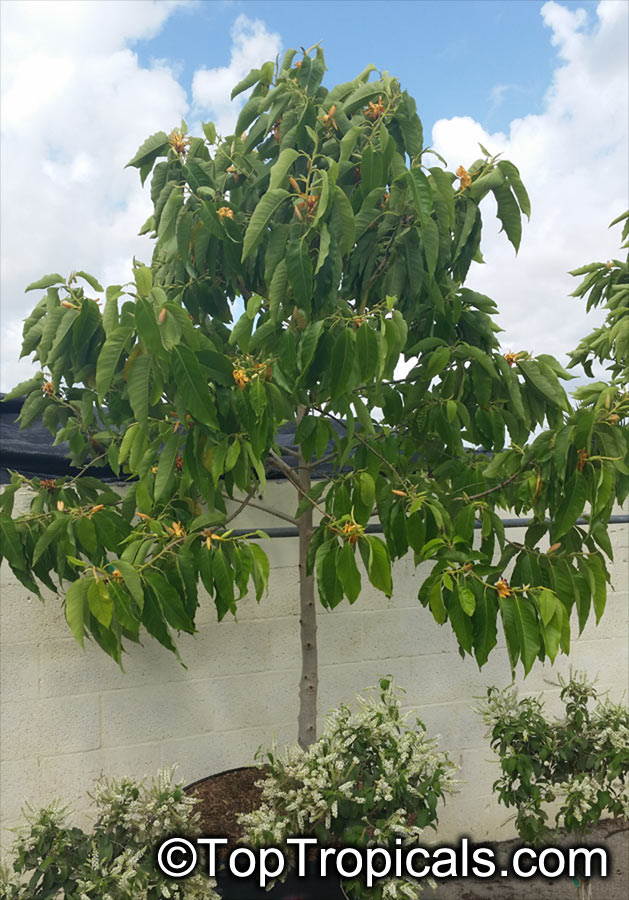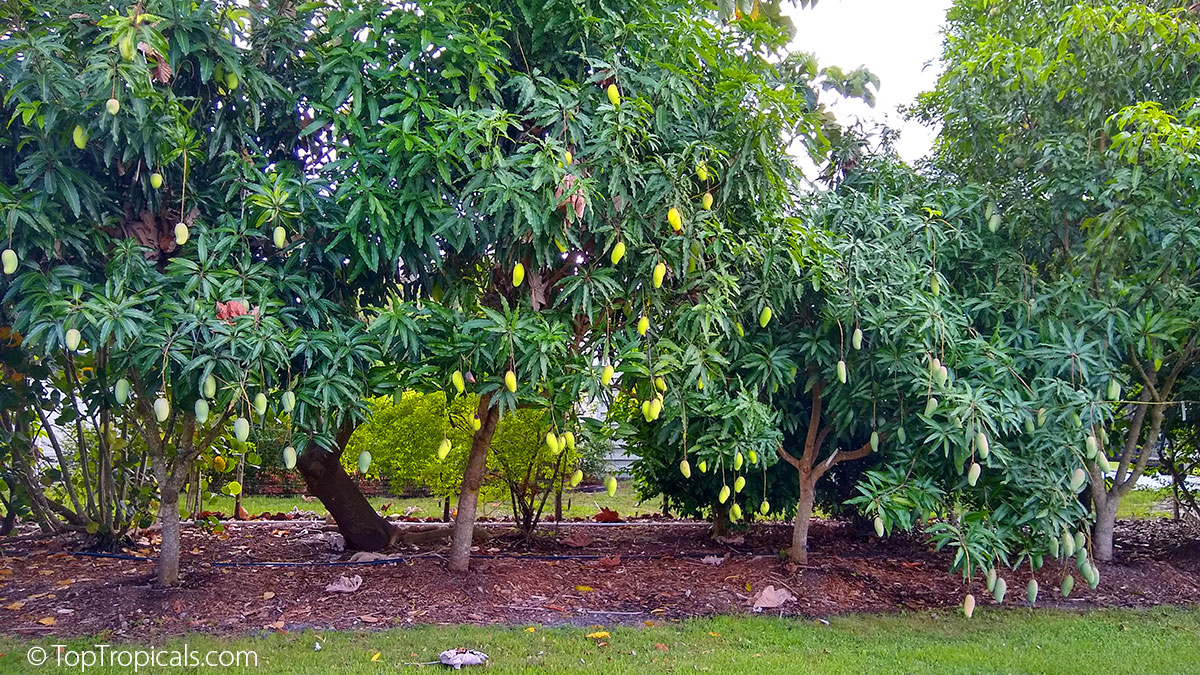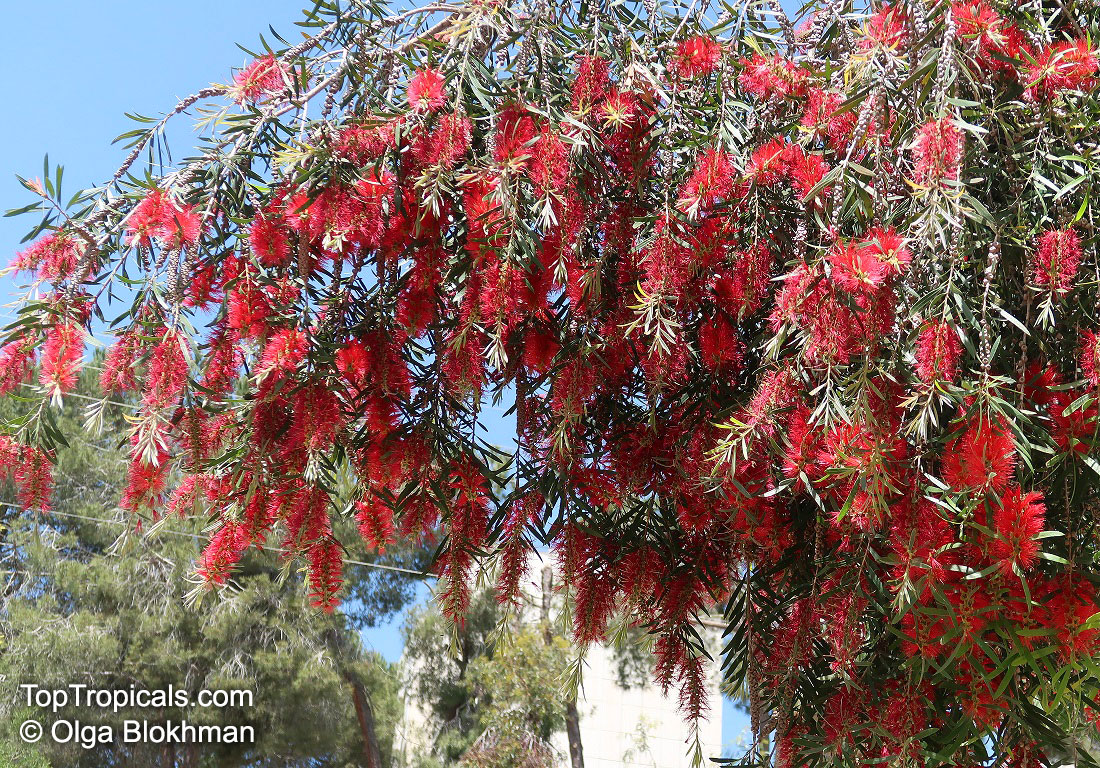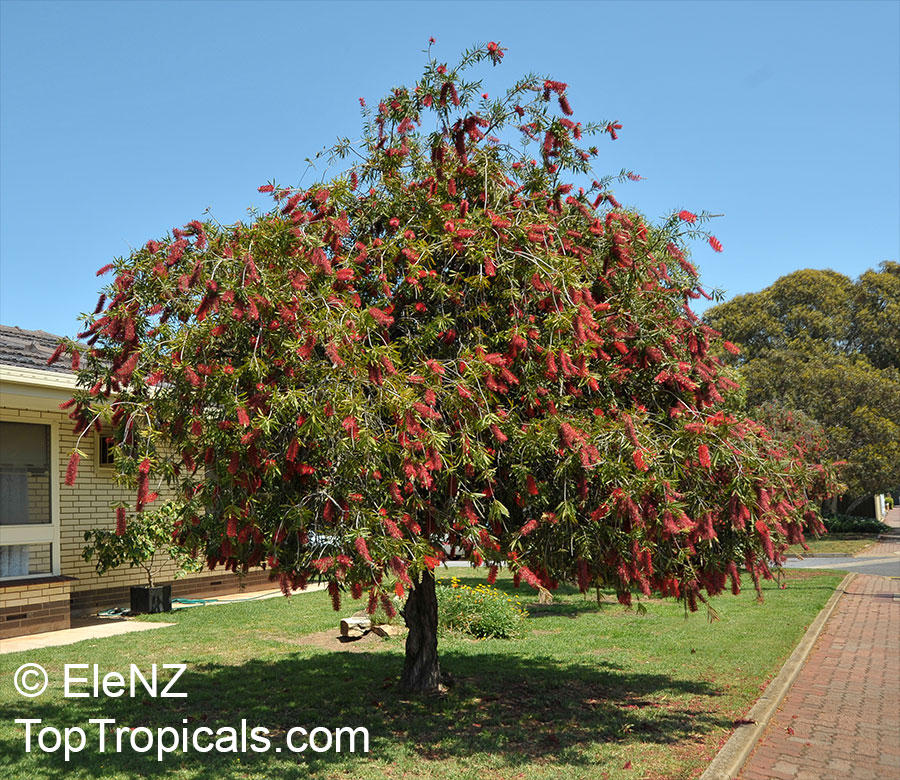Garden Blog - Top Tropicals
Date:
Bauhinias: trees with Orchid Flowers
and Butterfly Wings...
Photo above: Bauhinia variegata - Purple Orchid Tree, one of the most spectacular varieties.
Q: We just moved to Florida and I see these beautiful trees with large purple flowers. I was told these are Orchid trees, do you have them?
A: Bauhinias, commonly known as Orchid trees, are renowned for their captivating flowers and unique foliage. These trees typically grow to a moderate height of 15-25 feet with a spread of 10-15 feet, showcasing a rounded to vase-like shape. Thriving in hardiness zones 9-11, they exhibit resilience to heat and can withstand mild frost. There are over 300 species of Bauhinia, which are distributed in tropical and subtropical areas. These species vary in characteristics such as size, foliage, and flower color, contributing to the diversity and appeal of this genus. You can find them as trees, shrubs, and even vines.
Bauhinias are evergreen (in tropics) to semi-deciduous (in cooler climates), offering year-round beauty with intermittent blooming cycles. The peak bloom time varies depending on the species and location, often occurring in late winter to early spring, bedecking the tree with striking orchid-like flowers in hues ranging from white and pink to purple and red. The flowers boast delicate petals with intricate patterns, resembling the elegance of true orchids.
One of the distinguishing features of Bauhinia leaves is their unique bi-lobed or bilobed structure, which gives them a distinct appearance. The leaves are deeply divided, typically into two lobes or halves, hence the common name "Butterfly tree" due to their resemblance to butterfly wings. This characteristic is often used as an identifying trait for Bauhinia species. The bilobed leaves add to the visual appeal of the tree, contributing to its ornamental value in addition to its beautiful flowers.
Photo above: Bauhinia monandra - Napoleons Plume, starts flowering in small size. This one is very beautiful but the most cold sensitive and should be grown in pots in areas with winter freeze. It will happily bloom in container!
Low-maintenance by nature, Bauhinias require minimal upkeep. Annual feeding with a balanced fertilizer enhances growth and flowering. Pruning is generally optional but can be done in late winter or spring, after flowering, to maintain shape or remove dead or damaged branches. These trees thrive in full sun, preferring well-drained soil. With their enchanting blooms and easy care requirements, Bauhinia orchid trees are a delightful addition to any landscape, and a colorful specimen for tropical winter gardens.
In addition, Orchid trees grow fast and provide excellent shade. They can make a shady spot in your garden in no time, giving relief from the hot sun. This is really valuable, especially in places where it gets very hot. So, not only are Orchid trees pretty to look at with their lovely flowers, but they're also great for keeping you cool!
Read more about Bauninias:
Bauihnias: Orchid trees with Butterfly flowers... and leaves
Photo above: Bauhinia x alba (candida) - White orchid tree, the most cold hardy variety that can take light freeze once established.
Photo above: Bauhinia purpurea - Purple Orchid Tree, one of the most popular and easy trees in Southern landscapes.
Why Bauhinias are called Orchid Trees: orchid flowers with butterfly wings
Bauhinia trees have striking orchid-like flowers in hues ranging from white and pink to purple and red. The flowers boast delicate petals with intricate patterns, resembling the elegance of true orchids.
The leaves are deeply divided, typically into two lobes or halves, hence another common name "Butterfly tree" due to their resemblance to butterfly wings.
Need a fast growing, easy to care tree with beautiful blooms? Orchid trees offer quick shade solution and guarantee a spectacular winter flower show.
📚 Learn more about Orchid trees
🛒 Shop Orchid Trees
#Butterfly_Plants
🏵 TopTropicals
Need more ideas for compact and showy flowering trees? Try Rainbow Cassias
Rainbow cassia - Cassia Marginata.
- ♦️ Some hybrid cassias have spectacular color combinations and are called Rainbow Cassias.
- ♦️ We mentioned earlier some sunny, yellow-flowering cassias: Senna surattensis (Cassia glauca) - Scrambled Egg Bush, and Cassia siamea - Kassod Tree.
- ♦️ Other cassias can be pink or with multi-color flower combination, so-called Rainbow cassias (which are hybrids between yellow and pink cassias):
- ♦️ Cassia trees are compact, fast growing, tolerant to drought and poor soils, free-flowering and relatively cold hardy. Always a great choice!
Cassia grandis - Red Cassia
Cassia javanica - Apple Blossom Tree
Cassia marginata - Rainbow Shower Tree
Cassia roxburghii - Ceylon Senna
Cassia x nodosa - Pink Shower, Appleblossom.
❓ What cassias do you have in your garden? Share photos in comments👇
🎥 Rainbow cassia - Cassia Marginata.
🛒 Shop showy Cassia trees
#Butterfly_Plants #Trees
🏵 TopTropicals
Date:
When Bigger means Better
Everybody loves shopping online nowadays, and plants are no exception. Buying plants by mail order is not uncommon anymore; it only takes one click, and luckily, there are many sources - from big shopping malls like Amazon to small backyard nurseries that sell their seedlings on eBay or Facebook - all delivered to your door. But plants are alive... So when doing your online plant shopping, you must ensure that you fully enjoy your experience and are happy with a healthy plant that a) doesn't die; b) recovers quickly; and c) starts growing fast, so you can see flowers and fruit as soon as possible.
The rule of thumb for shipping plants: bigger plants undergo shipping better, experience less stress, less leaf drop, and recover quicker than plants with smaller root systems. So when it comes to buying plants online, the bigger, the better. Unfortunately, many mail-order plant sources may sell you a tiny twig that has very few chances of surviving. Shipping is very expensive today, so shipping a bigger size plant may cost more than the plant itself.
Below is a piece of advice on how to make the best plant selection for your garden...
Photo above: Loquat trees in 3 gal containers.
5 important rules on how to buy trees online
1. Find a source with bigger plants. Check reviews, ask friends
for recommendations, inquire from the company about the size of their plants
and how they pack their plants for shipping.
TopTropicals offers well-established, strong plants with developed root
system, in container sizes 1, 3, 7, 15 gallon, directly from a tropical
Florida growing farm. Our unique plant-packing techniques are state of the art!
2. Price not always reflects the size and quality of the plant
TopTropicals offers many deals, discounts and sales, while still
providing the biggest and strongest plants grown in real tropical conditions.
3. Most fruit trees must be grafted to produce good fruit. Make
sure you are not purchasing a seedling when it comes to Mango, Avocado,
Peaches and some other trees with named varieties that don't come true to seed.
TopTropicals offers only grafted - Mango,
Avocado and a large number of other tropical cultivars.
4. Pick up when possible from the nursery your ordered from, or
get a delivery, instead of shipping the plants. A drive to the nursery will save you more time and money in the
future, plus you can hand-pick the biggest and healthiest specimens.
TopTropicals is open 7 days a week for your convenience. Visit our Ft Myers Garden Center or Sebring Farm to select the biggest plants.
5. Take advantage of X-Large size plant material if you live
outside the tropical zone and are trying to zone-push your tropical garden.
Bigger plants will establish faster and have more chances to survive cold winters.
Again, it will save you money in a long run (although bigger plants may be
more expensive, but their survival rate is much higher when it comes to cold
nights).
TopTropicals offers X-Large flowering and fruiting trees (7-15-25
gallons), and most of the varieties you see in our online
store can be custom-ordered in big sizes. Delivery and installation
available.
Photo above: Avocado trees in 7 gal containers.
Photo above: Magnolia champaca - Joy Perfume Tree in 25 gal container.
Date:
Shade
Tree Discount Program
How to reduce an electric bill and energy costs?
Photo above: Cassia fistula - Golden Shower Tree - one of the most popular trees. This all time favorite is fast growing and elegant.
Q: How to reduce an electric bill and energy costs?
A: This summer is expected to be hot. And the next summer... and next... Want to reduce your electric bill and energy costs? There is an excellent solution: plant a shade tree! Once fully grown, these trees will help keep your house cooler and lower your energy expenses.
Today we are offering a special discount you can use for purchasing
trees that will keep your homes cooler in Summer and gardens warmer in Winter!
Check out Fast
Growing Shade Trees, as well as other flowering trees and fruit trees and use discount below:
GETSHADE
Your savings with this code:
5% off orders $100+
15% off orders $150+
20% off orders $200+
Excluding S/H. Excluding 15 gal material. Exp. 6-12-24
Photo above: Tabebuia - spectacular winter bloomer.
Photo above: Bauhinia blakeana - Hong Kong Orchid Tree. The most beautiful of all orchid trees.
Photo above: Mango trees now. Many varieties are vigorous, large trees.
Photo above: Cattley Guava Tree is an elegant solution for small spaces. Red Button French Kiss Ginger goes well with it!
What is the symbol of exotic allure? Meet legendary Coral Trees -
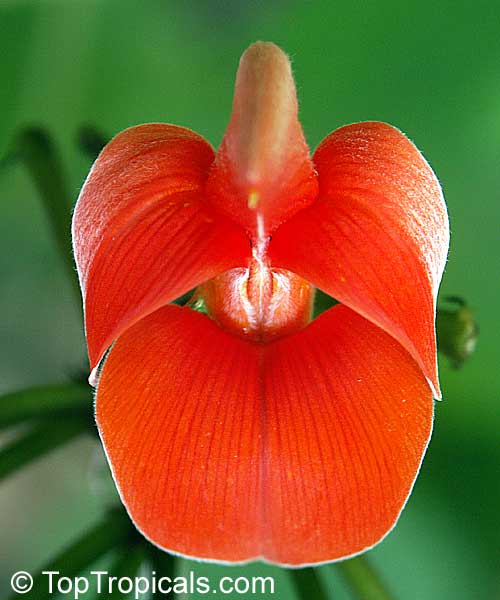
Coral Tree - Erythrina - Butea monosperma
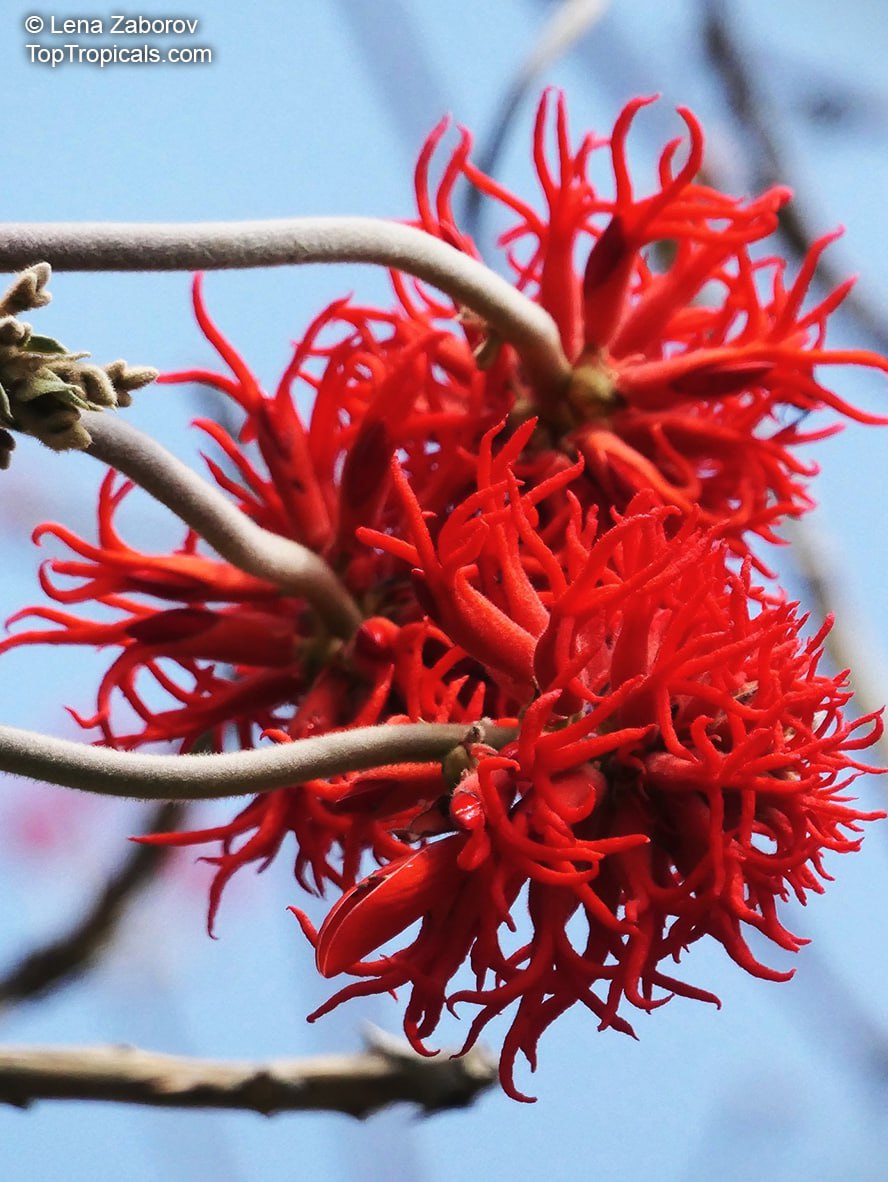
Coral Tree - Erythrina

Coral Tree - Erythrina

Coral Tree - Erythrina

Coral Tree - Erythrina

Coral Tree - Erythrina crysta-galli
- 💋 Vivid red blooms: striking, coral-red flowers that create a breathtaking visual display.
- 💋 Eye-catching: makes a stunning focal point with its bold and vibrant floral clusters.
- 💋 Fast-growing: quickly develops into a magnificent tree.
- 💋 Unique branch structure: an interesting, sculptural form that adds architectural interest even when not in bloom.
- 💋 Pollinator magnet: attracts hummingbirds, bees, and butterflies, supporting local wildlife. 🐞🐝
- 💋 Drought tolerant: withstands dry conditions once established.
- 💋 Adaptable: thrives in a range of soils, demonstrating versatility and hardiness.
- 💋 Low maintenance: requires minimal care.
- 💋 Legendary beauty: often considered a symbol of exotic allure, brings a touch of the extraordinary to a Southern landscape.
🛒 Shop Coral Trees
#Butterfly_Plants #Trees #Nature_Wonders
🏵 TopTropicals
How to add color to your yard
🔜 Lovely Cassias we mentioned in earlier post are in full bloom today - they love the Summer Heat! They are our favorite Summer flowers.
🔜 Cassia (Senna) trees are compact, fast growing, tolerant to drought and poor soils, free-flowering and relatively cold hardy. Always a great choice!
🔜 Cassias come in several colors: yellow, orange, pink, red and rainbow.
🔜 Yellow-flowering cassias:
🔜 Pink/red and multi-color Rainbow cassias (which are hybrids between yellow and pink cassias):
Senna surattensis (Cassia glauca) - Scrambled Egg Bush
Cassia siamea - Kassod Tree
Cassia didymobotrya - Popcorn Cassia
Senna alata - Empress Candles
Cassia occidentalis - Fedegoso, Coffee Senna
Cassia grandis - Red Cassia
Cassia javanica - Apple Blossom Tree
Cassia marginata - Rainbow Shower Tree
Cassia roxburghii - Ceylon Senna
Cassia x nodosa - Pink Shower, Appleblossom.
❔ What cassias do you have in your garden?
Share photos in comments👇
🛒 Shop showy Cassia trees
#Butterfly_Plants #Trees
🏵 TopTropicals
Index of TopTropicals Telegram Channel
Follow these tags to find your interests:
#Butterfly_Plants - Butterfly attracting plants.
#Container_Garden - Plants suitable for container garden and indoor culture.
#Fertilizers - All the truth about fertilizers, plant food supplements, and our recommendations for different types of plants.
#Food_Forest - Fruit trees, Spice plants, and Edibles.
Including: #Avocado, #Mango, #Papaya, #Guava, #Jackfruit, #Loquat
📖 #Fun_Facts - interesting plant facts and legends.
🌳 #Hedges_with_benefits - Practical approach to your landscape and how to properly select showy and useful plants for your yard.
♍️ #Horoscope - Plant Horoscopes and Cat Horoscopes. Did you know that cats also have their Zodiac signs?
🛠 #How_to - Q&A about growing plants, tropical garden lifehacks.
👀 #Nature_Wonders - Unusual, amusing, outrageous, bizarre plants...
🐈 #PeopleCats - our Favorite PeopleCats (and some PeopleDogs, too).
🌸 #Perfume_Plants - Fragrant plants and perfume trees.
✍️ #Quotes - Interesting quotes.
#Recipes - Exotic recipes for tropical fruit and edibles.
💊 #Remedies - Medicinal plants.
☁️ #Shade_Garden - Plants suitable for low light conditions.
🌼 #Trees - Spectacular flowering tropical trees.
🏆 #Win - Contests, Sweepstakes, and other specials.
Join and share with friends👇🏵
TopTropicals
Date:
How to grow Bottle brush trees
Q: Please recommend me a cold hardy flowering tree that doesn't need much care.
A: Growing bottle brush trees (Callistemon spp.) can be a rewarding experience, as they are known for their striking, brush-like flowers and ability to attract pollinators. Here are some detailed tips to help you successfully grow and maintain these trees.
Hardiness
Bottle brush trees are best suited for USDA hardiness zones 8-11. They thrive in warm climates and can tolerate some light frost, but severe cold can damage or kill the plant.
Planting Location
Sunlight: Bottle brush trees require full sun to thrive. Ensure they get at least 6-8 hours of direct sunlight per day.
Soil: They prefer well-draining soil. While they are relatively tolerant of poor soil conditions, a sandy or loamy
Space: Consider the mature size of the tree when planting. Some species can grow quite large, so provide enough space for them to spread without being crowded by other plants or structures.
Attracting Pollinators
Bottle brush trees are popular with pollinators. Their bright, nectar-rich flowers attract bees, butterflies, and birds, particularly hummingbirds. This makes them an excellent choice for a garden designed to support local wildlife.
Blooming and Fertilization
Bottle brush trees typically bloom in late spring to early summer. However, in mild climates, they may have sporadic blooms throughout the year.
Fertilization: While bottle brush trees do not require heavy fertilization, applying a balanced, slow-release fertilizer in spring can promote healthier growth and more abundant blooms. Be cautious not to over-fertilize, as this can lead to excessive foliage growth at the expense of flowers. During the year, use |find_name=Sunshine Boosters Megaflor(Sunshine Megaflor)| - it is safe to use with every watering, year around.
Watering
During the establishment period, keep the soil moist. Once established, they are quite drought-tolerant but will benefit from regular watering during dry spells.
Pruning
Prune after flowering to maintain shape and remove any dead or diseased branches. This also encourages bushier growth.
By following these guidelines, you can enjoy the beauty and benefits of bottle brush trees in your garden. Their vibrant flowers and attraction to pollinators make them a delightful addition to many landscapes.
Try cleaning bottles with this brush!
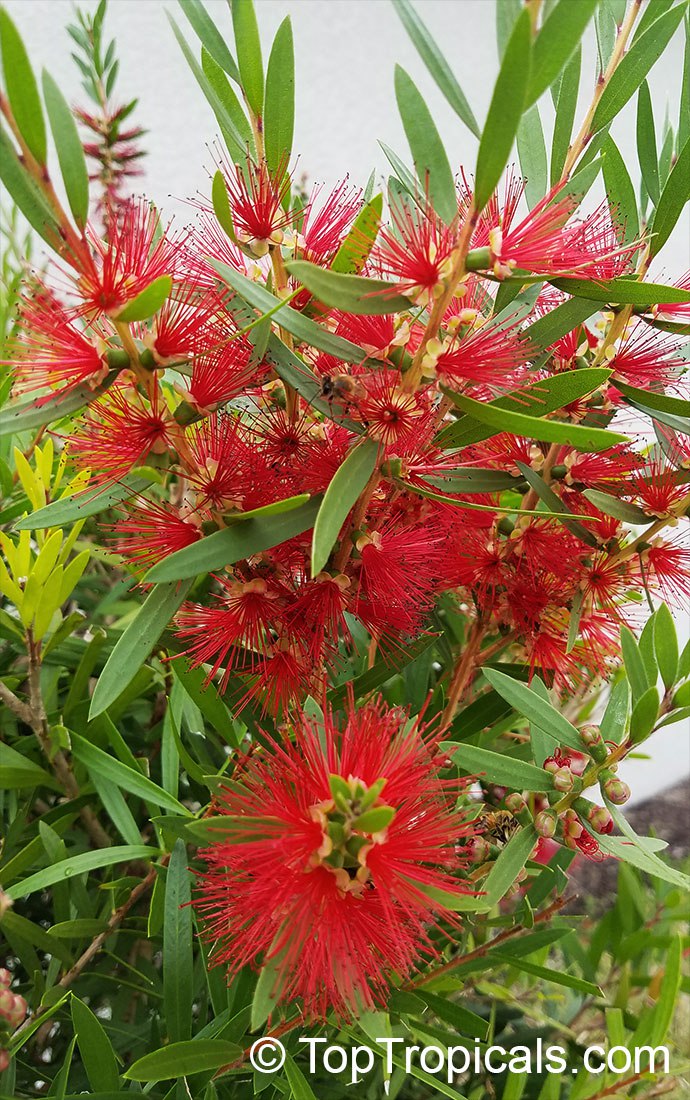
Bottlebrush Tree (Callistemon spp.)
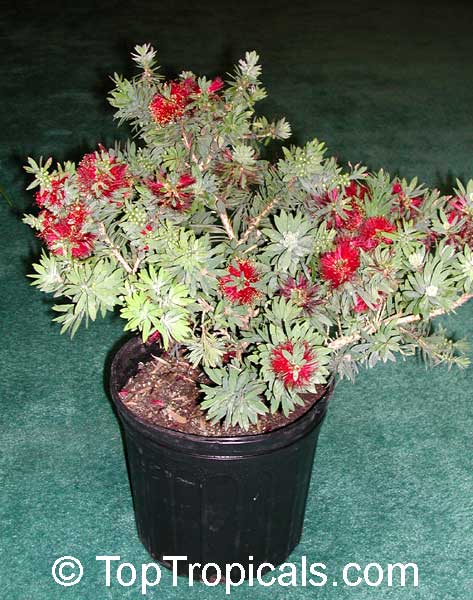
Bottlebrush Tree (Callistemon spp.) Little John
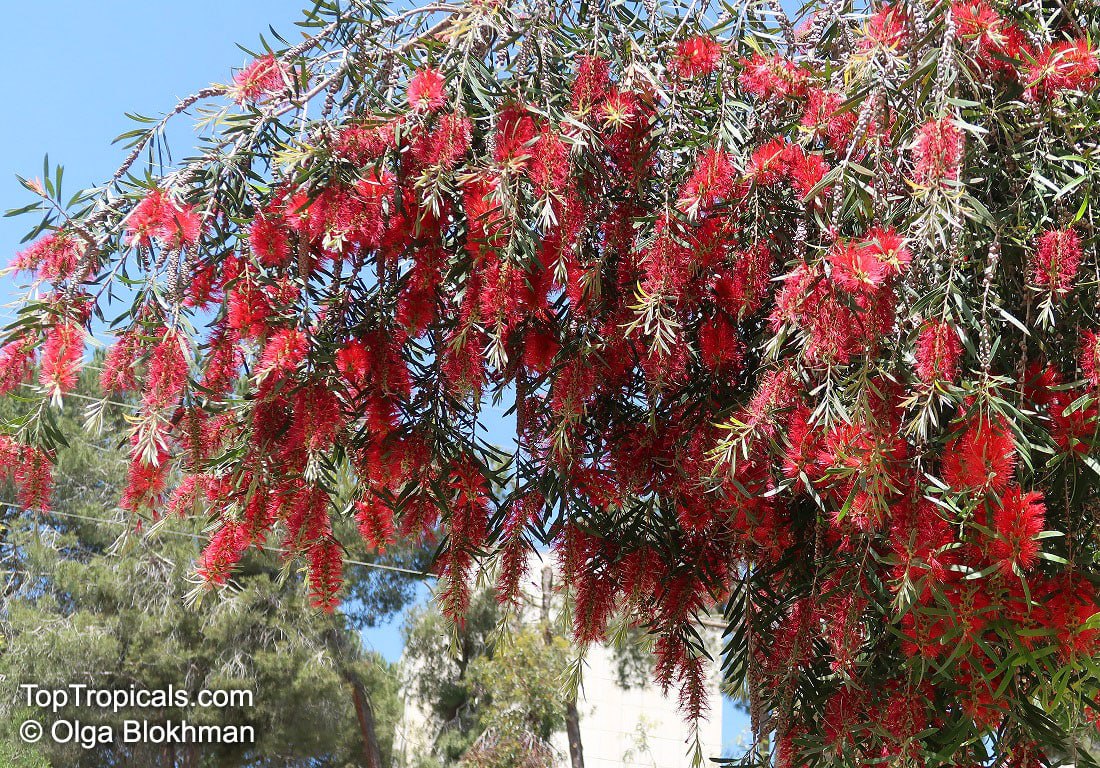
Bottlebrush Tree (Callistemon spp.)
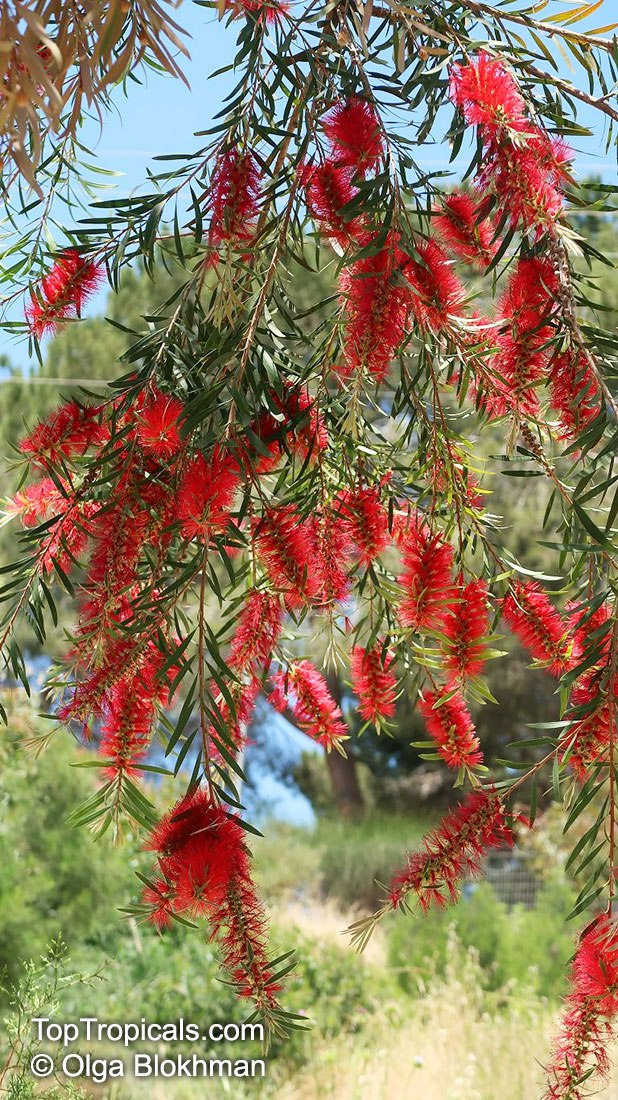
Bottlebrush Tree (Callistemon spp.)

Bottlebrush Tree (Callistemon spp.)
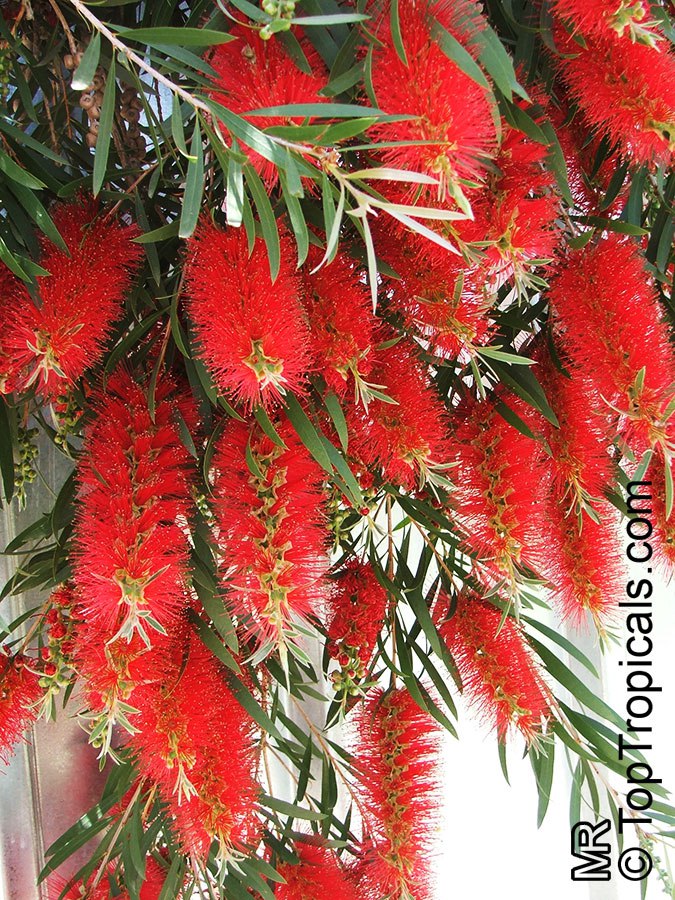
Bottlebrush Tree (Callistemon spp.)
- 🍾 Bottlebrush Tree (Callistemon spp.) is renowned for its spectacular, fire-red brush-like flowers and landscape appeal.
- 🍾 Originated from Australia, this exotic tree can add a touch of exotic charm to any landscape.
- 🍾 Cold hardy to zone 8, tolerates both cold and heat.
- 🍾 Its striking, vibrant flowers resemble bottle brushes.
- 🍾 Attracts pollinators such as bees, butterflies, and hummingbirds with its nectar-rich blooms.
- 🍾 Adds a burst of color and texture to gardens and landscapes.
- 🍾 Ideal for creating focal points, hedges, or as standalone specimens.
- 🍾 Thrives in warm climates and is drought-tolerant once established, making it a low-maintenance choice for Southern landscapes.
- 🍾 Offers many varieties, including the dwarf 'Little John,' perfect for containers, reaching only 4ft tall.
🛒 Shop Bottlebrush trees
#Butterfly_Plants #Hedges_with_benefits #Trees
🏵 TopTropicals
